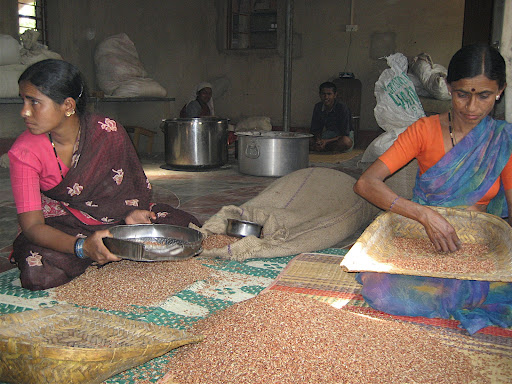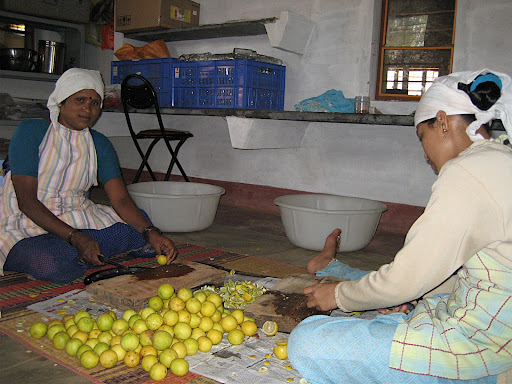 ND supplies many healthy, wholesome products through different outlets in Bangalore (Namdhari stores and homes of friends). They are trying to encourage the consumption of nutritious grains and millets that have been forgone by people in many parts of India.
ND supplies many healthy, wholesome products through different outlets in Bangalore (Namdhari stores and homes of friends). They are trying to encourage the consumption of nutritious grains and millets that have been forgone by people in many parts of India.
The staple diet for most people was not white rice. Many rural communities ate millets like ragi and jowar and various varieties of rice that were not necessarily polished. The same holds for dals. Eating polished dals was not always the norm. People worked their digestive systems by feeding them wholesome grains. As Fukuoka says in his book One Straw Revolution, our bodies did all the work that current day mills do!
So how did we get fixated with white rice? The PDS (Public Distribution System) in India was instituted to provide subsidized food grains to people. And the reductionist thought that went into making it also decided that all people could eat white rice. People had access to cheap foodgrains and soon got used to polished, white rice. In Sittinlingi (where we spent time at Thulir), the community was quite cut off from mainstream society till it got a road to Salem. People used to eat a kind of gruel made from ragi along with sundal for their protein. Most of these were grown on their own farms. With the coming of the ration shop, they had access to cheap rice (Rs. 2 / kg currently) and hence had less reason to grow their own food. Slowly, there is a trend of growing cash crops and using the returns to buy food from the ration shop. It is the same case in the Baligi Kandriga region where Bharathi Trust has started the resource center. People have adopted cheaper, less nutritious diets. The situation is no different in Gumalapuram. I was chatting with some of the women who work in ND’s health food unit. While they still grow some ragi for their own consumption, they have all switched to white rice. Unpolished, red rice that ND dehusks and packages sells at Rs. 25 a kg – much more expensive than what the ration shop can provide.
Why don’t they sell unpolished rice at least? Ananthu told me about his experience in getting the white rice dehusked but not polished. The person he approached for this agreed to do it but said he would be charged a fee to which Ananthu agreed. He then saw farmers bringing in paddy to be polished and not getting charged at all. On enquiring about this seeming injustice, the mill owner responded saying the pharmaceutical companies would pay him much more for the rice bran. They make their vitamin tablets from it. So we eat polished rice with not much nutritional value and those who can afford it, get their daily dose of vitamins from vitamin pills!
Back to ND. Not many of the grains are grown at ND, the soil still has not recovered enough to support agriculture. They have grown some ragi in the past and will be planting some this season too. Some of the local farmers have started growing red rice organically and supplying it to ND. ND members go to the farms and work with the farmers about organic methods etc. They don’t actively campaign a switch to organic farming but support farmers who go organic by purchasing their produce. Most of the people who come to work at ND from the village nearby own some land. Over the years, after observing how ND has been working to grow food organically, some of them have started using lesser and lesser urea, which I thought was great. Such organic work takes its own time.

They make different products: whole wheat atta, ragi flour, sprouted dalia, sprouted suji, red rice, dry idli and dosa mixes using red rice (the idlis have an interesting purplish tinge), turmeric, chilli powder, jaggery, pickles, gheeless sweets, chyawanprash, honey, and lime juice concentrate are some that I remember. The food I ate at ND was tasty, wholesome and not oily. They served ragi muddais and red rice for lunch and different items were served for dinner and breakfast. They prepared a large quantity of the vegetable dish, very different from my other visits where I was served more grains. I later learnt of their health food ideology that stresses on the importance of a lot of veggies in your diet. In fact, according to Partapji, we would do just fine on fruits and veggies. Our bodies can’t really handle grain, hence we need to grind them, soak them, boil them etc in order to be able to eat them. I guess if that much work is to go in just to eat a particular kind of food, you don’t really have to eat it! Not sure I can give up my latest craze, set dosa but I agree about not needing so much grain.


No comments:
Post a Comment